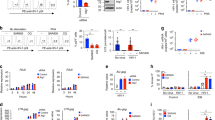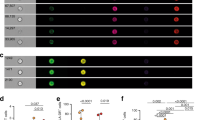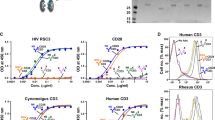Abstract
Although 13 years have passed since identification of human immunodeficiency virus-1 (HIV-1) as the cause of AIDS, we do not yet know how HIV kills its primary target, the T cell that carries the CD4 antigen. We and others have shown an increase in the percentage of apoptotic cells among circulating CD4+ (and CD8+) T cells of HIV-seropositive individuals and an increase in frequency of apoptosis with disease progression. However, it is not known if this apoptosis occurs in infected or uninfected T cells. We show here, using in situ labelling of lymph nodes from HIV-infected children and SIV-infected macaques, that apoptosis occurs predominantly in bystander cells and not in the productively infected cells themselves. These data have implications for pathogenesis and therapy, namely, arguing that rational drug therapy may involve combination agents targeting viral replication in infected cells and apoptosis of uninfected cells.
This is a preview of subscription content, access via your institution
Access options
Subscribe to this journal
Receive 12 print issues and online access
$209.00 per year
only $17.42 per issue
Buy this article
- Purchase on Springer Link
- Instant access to full article PDF
Prices may be subject to local taxes which are calculated during checkout
Similar content being viewed by others
References
Levy, J.A. Pathogenesis of human immunodeficiency virus infection. Microbiol Rev. 57, 183–289 1993.
Greene, W.C. AIDS and the immune system. Scient. Am. 269, 98–105 1993.
Finkel, T.H., & Banda, N.K., Indirect mechanisms of HIV pathogenesis how does HIV kill T cells? Curr Opin. Immun. 6, 605–615 1994.
Terai, C., Kornbluth, R.S., Pavia, D., Richman, D.D., & Carson, D.A., Apoptosis as a mechanism of cell death in cultured T lymphoblasts acutely infected with HIV-1. J. clin. Invest. 87, 1710–1715 1991.
Laurent-Crawford, A. et al. The cytopathic effect of HIV is associated with apoptosis. Virology 185, 829–839 1991.
Cohen, J.J. Apoptosis: The physiologic pathway of cell death. Hosp Pract. 28, 35–43 1993.
Groux, H., Monte, D., Bourrez, J.M., Capron, A. & Ameisen, J.C. Activation-induced death by apoptosis in CD4 T cells from human immunodeficiency virus-infected asymptomatic individuals. J. exp. Med. 175, 331–340 1992.
Meyaard, L. et al. Programmed death of T cells in HIV-1 infection. Science. 257, 217–219 1992.
Lewis, D.E., Ng Tang, D.S., Adu-Oppong, A., Schober, W. & Rodgers, J.R. Anergy and apoptosis in CD8+ T cells from HIV-mfected persons. J. Immun. 153, 412–420 1994.
Oyaizu, N. et al. Accelerated apoptosis in peripheral blood mononuclear cells (PBMCs) from human immunodeficiency virus type-1 infected patients and in CD4 cross-linked PBMCs from normal individuals. Blood. 82, 3075–3080 1993.
Gougeon, M., et al. Programmed cell death in AIDS-related HIV and SIV infections. AIDS Res. Hum. Retrovir. 9, 553–563 1993.
Pantaleo, G. et al. HIV infection is active and progressive in lymphoid tissue during the clinically latent stage of disease. Nature 362, 355–358 1993.
Embretson, J. et al. Massive covert infection of helper T lymphocytes and macrophages by HIV during the incubation period of AIDS. Nature 362, 359–362 1993.
Gorczyka, W., Bruno, S., Darzynkiewicz, R.J., Gong, J. & Darzynkiewicz, Z. DNA strand breaks during apoptosis Their early in situ detection by terminal deoxynucleotidyl transferase and nick translation assays and prevention by serme protease inhibitors. Int. J. Onc. 1, 639–648 1992.
Baba, T.W. et al. Mucosal infection of neonatal rhesus monkeys with cell-free SIV. AIDS Res. Hum. Retrovir. 10, 351–357 1994.
Goebel, W.S., Hommel-Berrey, G. & Brahmi, Z. Lymphokine-activated killer cells do not induce degradation of viral or cellular RNA in targets in which DNA fragmentation occurs. FASEB J. 6, A1335 1992.
Liu, Y.-J., Johnson, G.D., Gordon, J. & MacLennan I.C.M. Germinal centres in T-cell-dependent antibody responses. Immun. Today 13, 17–21 1992.
Kuby, J. Immunology (Freeman, New York, 1994).
Stein, H., Gerdes, J. & Mason, D.Y. The normal and malignant germinal centre. Clin Haematol. 11, 531–559 1982.
Gray, D., Kosco, M. & Stockinger, B. Novel pathways of antigen presentation for the maintenance of memory. Int Immun. 3, 141–148 1991.
Cameron, P.U. et al. Dendritic cells exposed to human immunodeficiency virus type-1 transmit a vigorous cytopathic infection to CD4+ T cells. Science 257, 383–387 1992.
Piatak, M et al. High levels of HIV-1 in plasma during all stages of infection determined by competitive PCR. Science 259, 1749–1754 1993.
Patterson, B.K. et al. Detection of HIV-1 DNA and messenger RNA in individual cells by PCR-driven in situ hybridization and flow cytometry. Science. 260, 976–979 1993.
Stevenson, M., Meier, C, Mann, A.M., Chapman, N. & Wasiak, W. Envelope glycoprotem of HIV induces interference and cytolysis resistance in CD4+ cells Mechanism for persistence in AIDS. Cell 53, 483–496 1993.
Kowalski, M., Bergeron, L., Dorfman, T., Haseltine, W. & Sodroski, J. Attenuation of human immunodeficiency virus type 1 cytopathic effect by a mutation affecting the transmembrane envelope glycoprotein. J. Virol. 65, 281–291 1991.
Schwartz, L.M. & Osborne, B.A. Programmed cell death, apoptosis and killer genes. Immun. Today 14, 582–590 1993.
Mosier, D.E., Gulizia, R.J., MacIsaad, P.D., Torbett, B.E. & Levy, J.A. Rapid loss of CD4+ T cells m human-PBL-SCID mice by noncytopathic HIV isolates. Science 260, 689–692 1993.
Bonyhadi, M.L. et al. HIV induces thymus depletion in vivo. Nature 363, 728–732 1993.
Aldrovandi, G.M. et al. The SCID-Hu mouse as a model for HIV-1 infection. Nature 363, 732–736 1993.
Banda, N.K. et al. Crosslmkmg CD4 by human immunodeficiency virus gp120 primes T cells for activation-induced apoptosis. J. exp Med. 176, 1099–1106 1992.
Weinhold, K.J. et al. HIV-1 gp120-mediated immune suppression and lymphocyte destruction in the absence of viral infection. J. Immun. 142, 3091–3097 1989.
Siliciano, R.F. et al. Analysis of host–virus interactions m AIDS with antigp120 T cell clones Effect of HIV sequence variation and a mechanism for CD4+ cell depletion Cell 54, 561–575 1988.
Lyerly, H.K., Matthews, T.J., Langlois, A.J., Bolognesi, D.P. & Weinhold, K.J. Human T-cell lymphotropic virus IIIB glycoprotem (gp120) bound to CD4 determinants on normal lymphocytes and expressed by infected cells serves as target for immune attack. Proc. natn. Acad. Sci. U.S.A. 84, 4601–4605 1987.
Fox, C.H. & Cottier-Fox, M. in Curr. Prot. in Immun. (eds Cohgan, J. E., Kruisbeek, A. M., Marguhes, D. H., Shevach,, E. M. & Strober, W.)1281-12821 (Green and Wiley, 1994).
Author information
Authors and Affiliations
Rights and permissions
About this article
Cite this article
Finkel, T., Tudor-Williams, G., Banda, N. et al. Apoptosis occurs predominantly in bystander cells and not in productively infected cells of HIV- and SIV-infected lymph nodes. Nat Med 1, 129–134 (1995). https://doi.org/10.1038/nm0295-129
Received:
Accepted:
Issue Date:
DOI: https://doi.org/10.1038/nm0295-129
This article is cited by
-
Mitochondrial disturbance related to increased caspase-1 of CD4+T cells in HIV-1 infection
BMC Infectious Diseases (2024)
-
Prolonged experimental CD4+ T-cell depletion does not cause disease progression in SIV-infected African green monkeys
Nature Communications (2023)
-
Association of cell free mitochondrial DNA and caspase-1 expression with disease severity and ARTs efficacy in HIV infection
Molecular Biology Reports (2021)
-
TIGIT limits immune pathology during viral infections
Nature Communications (2020)
-
Clearance of HIV infection by selective elimination of host cells capable of producing HIV
Nature Communications (2020)



